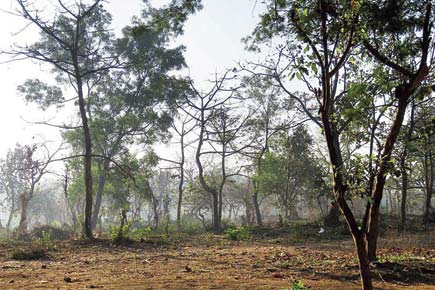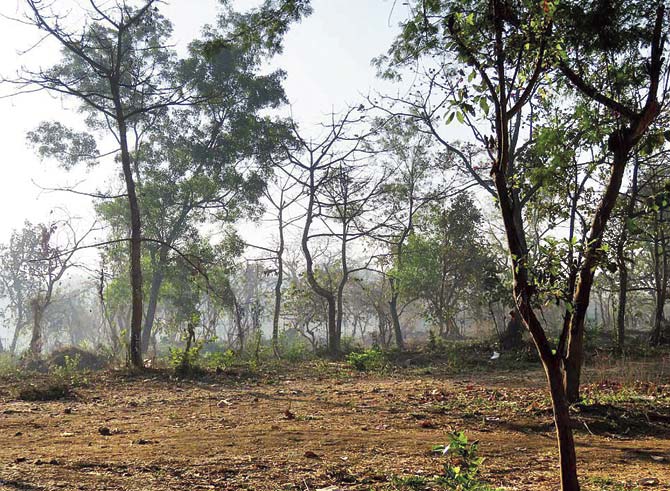Do we need to teach educated humans the value of trees? Seems like we do, at least to the city planners, developers and those hungry to strip the Earth of its green cover that has been laid out systematically over centuries of meticulous ecological planning!

 Do we need to teach educated humans the value of trees? Seems like we do, at least to the city planners, developers and those hungry to strip the Earth of its green cover that has been laid out systematically over centuries of meticulous ecological planning!
Do we need to teach educated humans the value of trees? Seems like we do, at least to the city planners, developers and those hungry to strip the Earth of its green cover that has been laid out systematically over centuries of meticulous ecological planning!
The Aarey Milk Colony (AMC) has been famous as a green belt for Mumbaikars and is a buffer zone to the Sanjay Gandhi National Park, and harbours similar species and, in fact, some unique ones too. A recent decision to construct a Metro yard on a 70-acre grassland-woodland patch which also has several perennial streams, with fish, frogs and water beetles, flowing through it — has raised the anxiety of concerned citizens and environmentalists!

The proposed Metro III yard site in Aarey Colony comprises both woodland and grassland
On a recent Nature trail to Aarey Colony, actually on the exact spot where the Metro III yard has been proposed where destruction is rampant due to the ‘No Wildlife Exists’ verdict given by RITES Ltd — we found nearly 30 species of trees in less than an hour!
There are many exotics such as the Rain tree, Copperpod, Baobab or Gulmohar lining the streets in Aarey (several are 70-80 years old) not only do they support orchids, climbers and have heritage value, they also hold the soil and shade us from the onslaught of the scorching sun. If aesthetics and history don’t seem to count, then surely indigenous trees with fruit (food), medicinal and ecological value will. Lined across one end of the yard are half-a-dozen Double coconut trees, (found in the Western Ghats and north-east India) that have grown to a towering 70-80 ft, and many of which harbour nests of Kites and crows! The minute you step off the road, you will encounter a huge diversity of trees, viz. Mango, Peepul, Jamun, Mahua, Ghost tree, Toddy Palm, Red Silk Cotton, Flame of the forest, Kachnar, Umbar, Banyan, Ber, Ain, Bhend, Haldu, Kalamb, Behda, Teak, Tamarind, Kusum, Amaltash/Indian Laburnum, Karanj, Shisham or Rosewood, Shirish, Gunda, Khirni.
Here are a few with their specialities: Mango (Mangifera indica) is currently in blossom and are ready to fruit in the coming months. It is the national fruit of India, Pakistan, the Phillipines and the national tree of Bangladesh. It is also the state tree of Gujarat and Maharashtra. A mango orchard reduces noise and air pollution, provides fragrance and is home to many migratory birds such as warblers and flycatchers, as well as butterflies, while skinks tend to forage among its dry leaves.
Peepul or Sacred Fig or the Bodhi tree (Ficus religiousa) is famed as the tree under which Gautam Buddha attained Nirvana (enlightenment) and is worshipped in many religions. Peepul also provides food during late winters and summers and is thronged by Hornbills, barbets, squirrels, parakeets and they may house owls, bat colonies and honeycombs. The plant is known to sequester a high quantity of carbon and hence important in climate and temperature control!
Jamun (Syzygium cumini) is an evergreen tree with astringent fruits that literally weigh the branches down. The fruits have anti-diabetic properties and can control blood sugar and glucosuria, besides the leaves and bark used against gingivitis. The fruits are made into a vinegar and wine and are a rich source of Vitamins A and C. They are excellent in controlling soil erosion and for carbon sequestration!
Mahua (Madhuca longifolia) is famous for the liquor produced from its pulpy fruits, which are consumed in profusion by animals, right from bats, monkeys, civets to even elephants. The plant is used by tribals to manufacture soap, vegetable fat and fuel oil, besides use in construction. The leaves are economically important for rearing Tussar Silk caterpillars. It is the state tree of Telangana!
Ghost tree (Sterculia urens) is one of the few trees that can grow right among the rocky cracks of volcanic plateaus and attract birds and bats to its itchy, pulpy fruits, and its seeds are roasted and eaten. Scores of beetles live under its flakes and the bark exudes a thick gum that is used a as fixative in dentures, or even as a laxative or thickener in medicines and cosmetics.
Red Silk Cotton (Bombax ceiba) or Semal attracts large flocks of birds, langurs, squirrels and bees to its pulpy red flowers and even a single tree is the hub of day-long activity, making it an ecologically important species. Rosy and Chestnut-tailed Starlings, Black and Racket-tailed Drongos, Tree Pies, Barbets and Jungle Crows feed on the nectar of the flowers!
With such a wide diversity, how can we simply destroy it all and lose the value and ecological services provided and label that development?
The writer is an ecologist and founder director of SPROUTS Environment Trust, a conservation awareness & research organisation
 Subscribe today by clicking the link and stay updated with the latest news!" Click here!
Subscribe today by clicking the link and stay updated with the latest news!" Click here!









